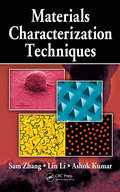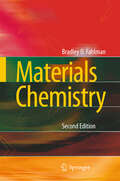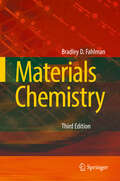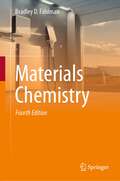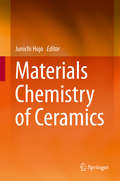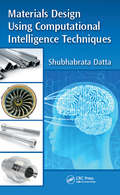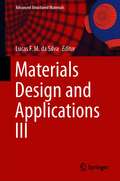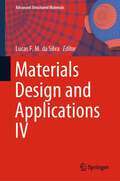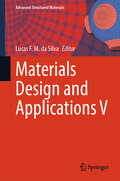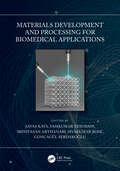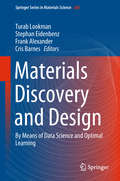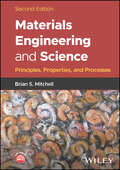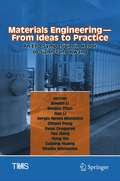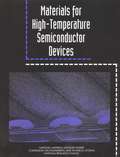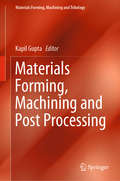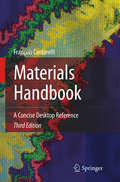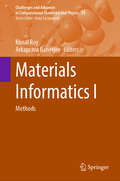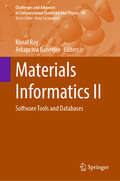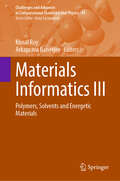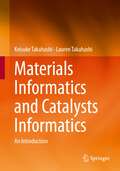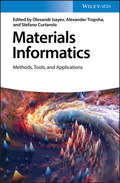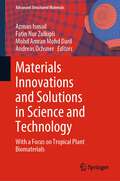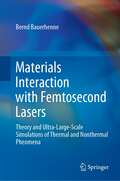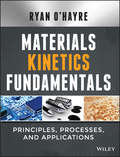- Table View
- List View
Materials Characterization Techniques
by Ashok Kumar Lin Li Sam ZhangExperts must be able to analyze and distinguish all materials, or combinations of materials, in use today-whether they be metals, ceramics, polymers, semiconductors, or composites. To understand a material's structure, how that structure determines its properties, and how that material will subsequently work in technological applications, researche
Materials Chemistry
by Bradley D. FahlmanThe 2nd edition of Materials Chemistry builds on the strengths that were recognized by a 2008 Textbook Excellence Award from the Text and Academic Authors Association (TAA). Materials Chemistry addresses inorganic-, organic-, and nano-based materials from a structure vs. property treatment, providing a suitable breadth and depth coverage of the rapidly evolving materials field -- in a concise format. The 2nd edition continues to offer innovative coverage and practical perspective throughout, e.g.: the opening solid-state chemistry chapter uses color illustrations of crystalline unit cells and digital photos of models to clarify their structures. This edition features more archetypical unit cells and includes fundamental principles of X-ray crystallography and band theory. In addition, an ample amorphous-solids section has been expanded to include more details regarding zeolite syntheses, as well as ceramics classifications and their biomaterial applications. The subsequent metals chapter has been re-organized for clarity, and continues to treat the full spectrum of powder metallurgical methods, complex phase behaviors of the Fe-C system and steels, and topics such as corrosion and shape-memory properties. The mining/processing of metals has also been expanded to include photographs of various processes occurring in an actual steelmaking plant. The semiconductor chapter addresses evolution and limitations/solutions of modern transistors, as well as IC fabrication and photovoltaics. Building on the fundamentals presented earlier, more details regarding the band structure of semiconductors is now included, as well as discussions of GaAs vs. Si for microelectronics applications, and surface reconstruction nomenclature. The emerging field of 'soft lithographic' patterning is now included in this chapter, and thin film deposition methodologies are also greatly expanded to now include more fundamental aspects of chemical vapor deposition (CVD) and atomic layer deposition (ALD). The polymer and 'soft' materials chapter represents the largest expansion for the 2nd edition. This chapter describes all polymeric classes including dendritic polymers, as well as important additives such as plasticizers and flame-retardants, and emerging applications such as molecular magnets and self-repairing polymers. This edition now features 'click chemistry' polymerization, silicones, conductive polymers and biomaterials applications such as biodegradable polymers, biomedical devices, drug delivery, and contact lenses. Final chapters on nanomaterials and materials-characterization techniques are also carefully surveyed, focusing on nomenclature, synthetic techniques, and applications taken from the latest scientific literature. The 2nd edition has been significantly updated to now include nanotoxicity, vapor-phase growth of 0-D nanostructures, and more details regarding synthetic techniques and mechanisms for solution-phase growth of various nanomaterials. Graphene, recognized by the 2010 Nobel Prize in Physics, is now also included in this edition. Most appropriate for Junior/Senior undergraduate students, as well as first-year graduate students in chemistry, physics, or engineering fields, Materials Chemistry may also serve as a valuable reference to industrial researchers. Each chapter concludes with a section that describes important materials applications, and an updated list of thought-provoking questions. The appendices have also been updated with additional laboratory modules for materials synthesis (e.g., porous silicon) and a comprehensive timeline of major materials developments.
Materials Chemistry
by Bradley D. FahlmanThe 3rd edition of this successful textbook continues to build on the strengths that were recognized by a 2008 Textbook Excellence Award from the Text and Academic Authors Association (TAA). Materials Chemistry addresses inorganic-, organic-, and nano-based materials from a structure vs. property treatment, providing a suitable breadth and depth coverage of the rapidly evolving materials field — in a concise format. The 3rd edition offers significant updates throughout, with expanded sections on sustainability, energy storage, metal-organic frameworks, solid electrolytes, solvothermal/microwave syntheses, integrated circuits, and nanotoxicity. Most appropriate for Junior/Senior undergraduate students, as well as first-year graduate students in chemistry, physics, or engineering fields, Materials Chemistry may also serve as a valuable reference to industrial researchers. Each chapter concludes with a section that describes important materials applications, and an updated list of thought-provoking questions.
Materials Chemistry
by Bradley D. FahlmanThis award-winning textbook delivers an earnest and comprehensive treatment of the rapidly evolving field of Materials Chemistry. It addresses inorganic-, organic-, and nano-based materials from a structure vs. property treatment, providing a suitable breadth and depth coverage of the field—in a concise and accessible format.The updated 4th edition features significant updates to glasses and ceramics, solid-state impurities, nanomaterial toxicity, as well as materials used in energy storage, photovoltaic, and electronics applications. Advanced fabrication techniques such as additive manufacturing (3-D printing) and dynamic light scattering (DLS) characterization of suspended nanoparticles are now also included. This new edition also expands the coverage of sustainability and life cycle analysis, of increasing importance for a world plagued with the effects of climate change.Recognized by a 2008 Textbook Excellence Award from the Text and Academic Authors Association (TAA), Fahlman’s Materials Chemistry is ideal for upper-level undergraduate students, as well as first-year graduate students in chemistry, physics, or engineering fields, and may also serve as a valuable reference to industrial researchers. Each chapter concludes with a section that describes important materials applications and an updated list of thought-provoking questions.
Materials Chemistry of Ceramics
by Junichi HojoThis book provides fundamental knowledge of ceramics science and technology in a compact volume. Based on inorganic chemistry, it is intended as a reader for graduate students and young researchers beginning work in ceramics. The importance of the book is that it provides a scientific understanding of structure, properties, and processing from the chemical aspect, leading to creation of future ceramics. Ceramics have high hardness, strength, thermal and chemical stability, as well as various electromagnetic functions. To take full advantage of ceramics, their use has been advanced to engineering and electronic ceramics. Most ceramics have been fabricated by powder processing, and new technologies have also evolved such as CVD and sol-gel methods: new ceramics aimed at new functions of highly pure oxides and artificial nitrides, carbides, and borides; fine ceramics focused on precise control of composition and microstructure; and design of unique morphology, such as nanoparticles, nanofibers, nanosheets, mesoporous materials, and hybrids. Materials are composed of atoms and molecules. They are assembled into crystals and are amorphous, leading to 3-D micro/nano structures. In addition to the topics described above, this book shows the importance of chemistry for materials design at the nanometer scale, and that chemistry develops new fields of environment, energy, informatics, biomaterials, and other areas.nojpkpo
Materials Data Science: Introduction to Data Mining, Machine Learning, and Data-Driven Predictions for Materials Science and Engineering (The Materials Research Society Series)
by Stefan SandfeldThis text covers all of the data science, machine learning, and deep learning topics relevant to materials science and engineering, accompanied by numerous examples and applications. Almost all methods and algorithms introduced are implemented “from scratch” using Python and NumPy. The book starts with an introduction to statistics and probabilities, explaining important concepts such as random variables and probability distributions, Bayes’ theorem and correlations, sampling techniques, and exploratory data analysis, and puts them in the context of materials science and engineering. Therefore, it serves as a valuable primer for both undergraduate and graduate students, as well as a review for research scientists and practicing engineers. The second part provides an in-depth introduction of (statistical) machine learning. It begins with outlining fundamental concepts and proceeds to explore a variety of supervised learning techniques for regression and classification, including advanced methods such as kernel regression and support vector machines. The section on unsupervised learning emphasizes principal component analysis, and also covers manifold learning (t-SNE and UMAP) and clustering techniques. Additionally, feature engineering, feature importance, and cross-validation are introduced. The final part on neural networks and deep learning aims to promote an understanding of these methods and dispel misconceptions that they are a “black box”. The complexity gradually increases until fully connected networks can be implemented. Advanced techniques and network architectures, including GANs, are implemented “from scratch” using Python and NumPy, which facilitates a comprehensive understanding of all the details and enables the user to conduct their own experiments in Deep Learning.
Materials Design Using Computational Intelligence Techniques
by Shubhabrata DattaSeveral statistical techniques are used for the design of materials through extraction of knowledge from existing data banks. These approaches are getting more attention with the application of computational intelligence techniques. This book illustrates the alternative but effective methods of designing materials, where models are developed through capturing the inherent correlations among the variables on the basis of available imprecise knowledge in the form of rules or database, as well as through the extraction of knowledge from experimental or industrial database, and using optimization tools.
Materials Design and Applications III (Advanced Structured Materials #149)
by Lucas F. M. da SilvaThis book offers selected contributions to fundamental research and application in designing and engineering materials. It focuses on mechanical engineering applications such as automobile, railway, marine, aerospace, biomedical, pressure vessel technology, and turbine technology. This includes a wide range of material classes, like lightweight metallic materials, polymers, composites, and ceramics. Advanced applications include manufacturing using the new or newer materials, testing methods, and multi-scale experimental and computational aspects.
Materials Design and Applications IV (Advanced Structured Materials #168)
by Lucas F. M. da SilvaThis book offers selected contributions on fundamental research and application in designing and engineering materials. It focuses on mechanical engineering applications such as automobile, railway, marine, aerospace, biomedical, pressure vessel technology, turbine technology. This includes a wide range of material classes, like lightweight metallic materials, polymers, composites, and ceramics. Advanced applications include manufacturing using the new or newer materials, testing methods, multi-scale experimental and computational aspects.
Materials Design and Applications V (Advanced Structured Materials #212)
by Lucas F. M. da SilvaThis book discusses several issues relevant to materials design and applications. The focus is on fundamental research and application areas in the field of the design and application of engineering materials, predominantly within the context of mechanical engineering applications. This includes a wide range of materials engineering and technology, including metals, e.g., lightweight metallic materials, polymers, composites, and ceramics. Advanced applications include manufacturing of new materials, testing methods, multi-scale experimental and computational aspects. The book publishes selected papers presented at the 5th International Conference on Materials Design and Applications 2024 (MDA 2024), held during July 4–5, 2024.
Materials Development and Processing for Biomedical Applications
by Savaş Kaya Sasikumar Yesudass Srinivasan Arthanari Sivakumar Bose Goncagül SerdaroğluMaterials Development and Processing for Biomedical Applications focuses on various methods of manufacturing, surface modifications, and advancements in biomedical applications. This book examines in detail about five different aspects including, materials properties, development, processing, surface coatings, future perspectives and fabrication of advanced biomedical devices. Fundamental aspects are discussed to better understand the processing of various biomedical materials such as metals, ceramics, polymers, composites, etc. A wide range of surface treatments are covered in this book that will be helpful for the readers to understand the importance of surface treatments and their future perspectives. Additional Features Include: Examines various properties of biomedical materials at the beginning in several chapters which will enrich the fundamental knowledge of the readers. Discusses advancements in various fields of biomedical applications. Provides a glimpse of characterization techniques for the evaluation of material properties. Addresses biocompatibility, biocorrosion, and tribocorrosion. This book explores new and novel strategies for the development of materials and their biomedical applications. It will serve as a comprehensive resource for both students and scientists working in materials and biomedical sciences.
Materials Discovery and Design: By Means of Data Science and Optimal Learning (Springer Series in Materials Science #280)
by Turab Lookman Frank Alexander Stephan Eidenbenz Cris BarnesThis book addresses the current status, challenges and future directions of data-driven materials discovery and design. It presents the analysis and learning from data as a key theme in many science and cyber related applications. The challenging open questions as well as future directions in the application of data science to materials problems are sketched. Computational and experimental facilities today generate vast amounts of data at an unprecedented rate. The book gives guidance to discover new knowledge that enables materials innovation to address grand challenges in energy, environment and security, the clearer link needed between the data from these facilities and the theory and underlying science. The role of inference and optimization methods in distilling the data and constraining predictions using insights and results from theory is key to achieving the desired goals of real time analysis and feedback. Thus, the importance of this book lies in emphasizing that the full value of knowledge driven discovery using data can only be realized by integrating statistical and information sciences with materials science, which is increasingly dependent on high throughput and large scale computational and experimental data gathering efforts. This is especially the case as we enter a new era of big data in materials science with the planning of future experimental facilities such as the Linac Coherent Light Source at Stanford (LCLS-II), the European X-ray Free Electron Laser (EXFEL) and MaRIE (Matter Radiation in Extremes), the signature concept facility from Los Alamos National Laboratory. These facilities are expected to generate hundreds of terabytes to several petabytes of in situ spatially and temporally resolved data per sample. The questions that then arise include how we can learn from the data to accelerate the processing and analysis of reconstructed microstructure, rapidly map spatially resolved properties from high throughput data, devise diagnostics for pattern detection, and guide experiments towards desired targeted properties. The authors are an interdisciplinary group of leading experts who bring the excitement of the nascent and rapidly emerging field of materials informatics to the reader.
Materials Engineering and Science: Principles, Properties, and Processes
by Brian S. MitchellMaterials Engineering and Science Understand the relationship between processing and material properties with this streamlined introduction Materials engineering focuses on the complex and crucial relationship between the physical properties of materials and the chemical bonds that comprise them. Specifically, this field of study seeks to understand how materials can be designed to meet specific design and performance criteria. This ‘materials paradigm’ has, in recent years, become integral to numerous cutting-edge areas of technological development. Materials Engineering and Science seeks to introduce this vital and fast-growing subject to a new generation of scientists and engineers. It integrates core thermodynamic, kinetic, and transport principles into its analysis of the structural, mechanical, and physical properties of materials, creating a streamlined and intuitive approach that fosters understanding. Now fully revised to reflect the latest research and educational paradigms, this is an essential resource. Readers of the second edition will also find: Detailed discussion of all major classes of materials, including polymers, composites, and biologicsNew and expanded treatment of nanomaterials, additive manufacturing (3D printing), and molecular simulationWeb-based and physical supplementary materials including an instructor guide, solutions manual, and sample lecture slides Materials Engineering and Science is ideal for all advanced undergraduate and early graduate students in engineering, materials science, and related subjects.
Materials Engineering—From Ideas to Practice: An EPD Symposium in Honor of Jiann-Yang Hwang (The Minerals, Metals & Materials Series)
by Yong Shi Jian Li Dean Gregurek Baojun Zhao Tao Jiang Shadia Ikhmayies Sergio Neves Monteiro Bowen Li Zhiwei Peng Cuiping HuangThis collection honoring Professor Jiann-Yang Hwang focuses on characterization and processing development in minerals, metals, and materials. Topics include but are not limited to:• Characterization methodology of minerals, metals, and materials• Microwave-assisted material processes• Recycling and reuse of metallurgical byproducts• Materials for hydrogen storage• Wastewater treatment and environmental protection• Natural materials for value-added applications• Principles and interactions of material characterization and manufacturing processing
Materials For High-Temperature Semiconductor Devices
by Committee on Materials for High-Temperature Semiconductor DevicesMajor benefits to system architecture would result if cooling systems for components could be eliminated without compromising performance. This book surveys the state-of-the-art for the three major wide bandgap materials (silicon carbide, nitrides, and diamond), assesses the national and international efforts to develop these materials, identifies the technical barriers to their development and manufacture, determines the criteria for successfully packaging and integrating these devices into existing systems, and recommends future research priorities.
Materials Forming, Machining and Post Processing (Materials Forming, Machining and Tribology)
by Kapil GuptaThis book provides a detailed understanding of various forming, machining, and post processing techniques. Working principle, process mechanism, salient features and latest developments are primarily focused. It presents some basic and specialized processes to produce quality engineered parts. This book also incorporates some investigations on modelling, simulation and optimization of the aforementioned processes to improve quality and performance, productivity, and sustainability.
Materials Handbook: A Concise Desktop Reference
by François CardarelliThe unique and practical Materials Handbook (third edition) provides quick and easy access to the physical and chemical properties of very many classes of materials. Its coverage has been expanded to include whole new families of materials such as minor metals, ferroalloys, nuclear materials, food, natural oils, fats, resins, and waxes. Many of the existing families—notably the metals, gases, liquids, minerals, rocks, soils, polymers, and fuels—are broadened and refined with new material and up-to-date information. Several of the larger tables of data are expanded and new ones added. Particular emphasis is placed on the properties of common industrial materials in each class. After a chapter introducing some general properties of materials, each of twenty classes of materials receives attention in its own chapter. The health and safety issues connected with the useand handling of industrial materials are included. Detailed appendices provide additional information on subjects as diverse as crystallography, spectroscopy, thermochemical data, analytical chemistry, corrosion resistance, and economic data for industrial and hazardous materials. Specific further reading sections and a general bibliography round out this comprehensive guide. The index and tabular format of the book makes light work of extracting what the reader needs to know from the wealth of factual information within these covers. Dr. François Cardarelli has spent many years compiling and editing materials data. His professional expertise and experience combine to make this handbook an indispensable reference tool for scientists and engineers working in numerous fields ranging from chemical to nuclear engineering. Particular emphasis is placed on the properties of common industrial materials in each class. After a chapter introducing some general properties of materials, materials are classified as follows. ferrous metals and their alloys; ferroalloys; common nonferrous metals; less common metals; minor metals; semiconductors and superconductors; magnetic materials; insulators and dielectrics; miscellaneous electrical materials; ceramics, refractories and glasses; polymers and elastomers; minerals, ores and gemstones; rocks and meteorites; soils and fertilizers; construction materials; timbers and woods; fuels, propellants and explosives; composite materials; gases; liquids; food, oils, resin and waxes; nuclear materials. food materials
Materials Informatics I: Methods (Challenges and Advances in Computational Chemistry and Physics #39)
by Kunal Roy Arkaprava BanerjeeThis contributed volume explores the integration of machine learning and cheminformatics within materials science, focusing on predictive modeling techniques. It begins with foundational concepts in materials informatics and cheminformatics, emphasizing quantitative structure-property relationships (QSPR). The volume then presents various methods and tools, including advanced QSPR models, quantitative read-across structure-property relationship (q-RASPR) models, optimization strategies with minimal data, and in silico studies using different descriptors. Additionally, it explores machine learning algorithms and their applications in materials science, alongside innovative modeling approaches for quantum-theoretic properties. Overall, the book serves as a comprehensive resource for understanding and applying machine learning in the study and development of advanced materials and is a useful tool for students, researchers and professionals working in these areas.
Materials Informatics II: Software Tools and Databases (Challenges and Advances in Computational Chemistry and Physics #40)
by Kunal Roy Arkaprava BanerjeeThis contributed volume explores the application of machine learning in predictive modeling within the fields of materials science, nanotechnology, and cheminformatics. It covers a range of topics, including electronic properties of metal nanoclusters, carbon quantum dots, toxicity assessments of nanomaterials, and predictive modeling for fullerenes and perovskite materials. Additionally, the book discusses multiscale modeling and advanced decision support systems for nanomaterial risk management, while also highlighting various machine learning tools, databases, and web platforms designed to predict the properties of materials and molecules. It is a comprehensive guide and a great tool for researchers working at the intersection of machine learning and material sciences.
Materials Informatics III: Polymers, Solvents and Energetic Materials (Challenges and Advances in Computational Chemistry and Physics #41)
by Kunal Roy Arkaprava BanerjeeThis contributed volume focuses on the application of machine learning and cheminformatics in predictive modeling for organic materials, polymers, solvents, and energetic materials. It provides an in-depth look at how machine learning is utilized to predict key properties of polymers, deep eutectic solvents, and ionic liquids, as well as to improve safety and performance in the study of energetic and reactive materials. With chapters covering polymer informatics, quantitative structure–property relationship (QSPR) modeling, and computational approaches, the book serves as a comprehensive resource for researchers applying predictive modeling techniques to advance materials science and improve material safety and performance.
Materials Informatics and Catalysts Informatics: An Introduction
by Keisuke Takahashi Lauren TakahashiThis textbook is designed for students and researchers who are interested in materials and catalysts informatics with little to no prior experience in data science or programming languages. Starting with a comprehensive overview of the concept and historical context of materials and catalysts informatics, it serves as a guide for establishing a robust materials informatics environment. This essential resource is designed to teach vital skills and techniques required for conducting informatics-driven research, including the intersection of hardware, software, programming, machine learning within the field of data science and informatics. Readers will explore fundamental programming techniques, with a specific focus on Python, a versatile and widely-used language in the field. The textbook explores various machine learning techniques, equipping learners with the knowledge to harness the power of data science effectively. The textbook provides Python code examples, demonstrating materials informatics applications, and offers a deeper understanding through real-world case studies using materials and catalysts data. This practical exposure ensures readers are fully prepared to embark on their informatics-driven research endeavors upon completing the textbook. Instructors will also find immense value in this resource, as it consolidates the skills and information required for materials informatics into one comprehensive repository. This streamlines the course development process, significantly reducing the time spent on creating course material. Instructors can leverage this solid foundation to craft engaging and informative lecture content, making the teaching process more efficient and effective.
Materials Informatics: Methods, Tools, and Applications
by Olexandr Isayev Alexander Tropsha Stefano CurtaroloProvides everything readers need to know for applying the power of informatics to materials science There is a tremendous interest in materials informatics and application of data mining to materials science. This book is a one-stop guide to the latest advances in these emerging fields. Bridging the gap between materials science and informatics, it introduces readers to up-to-date data mining and machine learning methods. It also provides an overview of state-of-the-art software and tools. Case studies illustrate the power of materials informatics in guiding the experimental discovery of new materials. Materials Informatics: Methods, Tools and Applications is presented in two parts?Methodological Aspects of Materials Informatics and Practical Aspects and Applications. The first part focuses on developments in software, databases, and high-throughput computational activities. Chapter topics include open quantum materials databases; the ICSD database; open crystallography databases; and more. The second addresses the latest developments in data mining and machine learning for materials science. Its chapters cover genetic algorithms and crystal structure prediction; MQSPR modeling in materials informatics; prediction of materials properties; amongst others. -Bridges the gap between materials science and informatics -Covers all the known methodologies and applications of materials informatics -Presents case studies that illustrate the power of materials informatics in guiding the experimental quest for new materials -Examines the state-of-the-art software and tools being used today Materials Informatics: Methods, Tools and Applications is a must-have resource for materials scientists, chemists, and engineers interested in the methods of materials informatics.
Materials Innovations and Solutions in Science and Technology: With a Focus on Tropical Plant Biomaterials (Advanced Structured Materials #173)
by Andreas Öchsner Azman Ismail Mohd Amran Mohd Daril Fatin Nur ZulkipliThis book offers innovative ideas and solutions from tropical fruits and crops for engineering problems. It covers a wide range of topics related to science, engineering, and technologies. The topics shared in this book enable practitioners and innovators to develop subsequent novel ideas and methods for solving engineering and technological problems for organizations to sustain its operation in global challenges.
Materials Interaction with Femtosecond Lasers: Theory and Ultra-Large-Scale Simulations of Thermal and Nonthermal Pheomena
by Bernd BauerhenneThis book presents a unified view of the response of materials as a result of femtosecond laser excitation, introducing a general theory that captures both ultrashort-time non-thermal and long-time thermal phenomena. It includes a novel method for performing ultra-large-scale molecular dynamics simulations extending into experimental and technological spatial dimensions with ab-initio precision. For this, it introduces a new class of interatomic potentials, constructed from ab-initio data with the help of a self-learning algorithm, and verified by direct comparison with experiments in two different materials — the semiconductor silicon and the semimetal antimony.In addition to a detailed description of the new concepts introduced, as well as giving a timely review of ultrafast phenomena, the book provides a rigorous introduction to the field of laser–matter interaction and ab-initio description of solids, delivering a complete and self-contained examination of the topic from the very first principles. It explains, step by step from the basic physical principles, the underlying concepts in quantum mechanics, solid-state physics, thermodynamics, statistical mechanics, and electrodynamics, introducing all necessary mathematical theorems as well as their proofs. A collection of appendices provide the reader with an appropriate review of many fundamental mathematical concepts, as well as important analytical and numerical parameters used in the simulations.
Materials Kinetics Fundamentals
by Ryan O'HayreIntroductory kinetics for the undergrad materials scientist Materials Kinetics Fundamentals is an accessible and interesting introduction to kinetics processes, with a focus on materials systems. Designed for the undergraduate student, this book avoids intense mathematics to present the theory and application of kinetics in a clear, reader-friendly way. Students are first introduced to the fundamental concepts of kinetics, with illustrated diagrams, examples, text boxes, and homework questions that impart a unified, intuitive understanding. Further chapters cover the application of these concepts in the context of materials science, with real-world examples including silicon processing and integrated circuit fabrication, thin-film deposition, carbon-14 dating, steel degassing, energy conversion, and more. Instructor materials including PowerPoint presentations, a test bank, and more are available through the companion website, providing a complete resource for the undergraduate materials science student. At its core, kinetics deals with rates, telling us how fast something will take place – for example, how fast water will evaporate, or how fast molten silicon will solidify. This book is designed to provide students with an introduction to kinetics' underlying principles, without rigorous math to distract from understanding. Understand universally important kinetic concepts like diffusion and reaction rate Model common kinetic processes both quantitatively and qualitatively Learn the mechanisms behind important and interesting materials systems Examine the behaviors, properties, and interactions of relevant solid materials There are a large number of books on chemical kinetics, but there are far fewer that focus on materials kinetics, and virtually none that provide an accessible, introductory-level treatment of the subject. Materials Kinetics Fundamentals fills that need, with clear, detailed explanations of these universal concepts.
